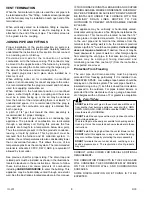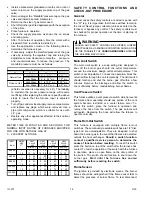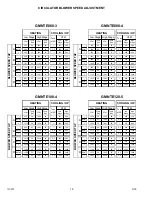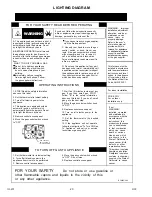
IO-231
6/03
6
SOURCE OF COMBUSTION AIR
The recommended source of combustion air is to use the
outdoor air supply. However, the use of indoor air in most
applications is acceptable except as follows;
1. If the furnace is installed in a confined space the
necessary combustion must come from outdoors by
way of the attic, crawl space, or direct opening to the
outside.
2. If indoor combustion is used, there must be no
exposure to the substances listed in #3 below.
3. The following installations may require OUTDOOR AIR
for combustion, due to chemical exposures;
•
Commercial buildings
•
Buildings with indoor pools
•
Furnaces installed in laundry rooms
•
Furnaces installed in hobby or craft rooms
•
Furnaces installed near chemical storage
areas
Exposures to the following substances in the
combustion air supply may also require OUTDOOR
AIR for combustion;
•
Permanent wave solutions
•
Chlorinated waxes and cleaners
•
Chlorine based swimming pool chemicals
•
De-icing salts or chemicals
•
Carbon tetrachloride
•
Halogen type refrigerants
•
Cleaning solvents (such as
perchloroethylene)
•
Printing inks, paint removers, varnishes, etc.
•
Hydrochloric acid
•
Cements and glues
•
Antistatic fabric softeners for clothes dryers
•
Masonry acid washing materials
VENTING
ANNUAL inspections of the furnace and it’s vent /
combustion air supply is strongly recommended. It is the
contractor’s responsibility to inform the user of this
importance.
All venting shall be in accordance with Part 7; Venting of
Equipment, of the National Fuel Gas Code, ANSI Z223.1,
or applicable local building and/ or air conditioning codes.
PROPER INSTALLATION OF THE VENT / COMBUSTION
AIR SYSTEMS IS CRITICAL TO SAFE OPERATION OF
THIS APPLIANCE. CAREFULLY READ AND
UNDERSTAND THE INSTRUCTIONS IN THIS SECTION.
EACH VENT AND COMBUSTION AIR SUPPLY PIPE
MUST SERVE ONLY ONE APPLIANCE. DO NOT
CONNECT TO AN EXISTING VENT OR CHIMNEY
UNLESS IT CONFORMS TO ALL PROVISIONS IN THIS
INSTRUCTION BOOKLET.
THE VENT MUST
TERMINATE OUTDOORS.
VENT/COMBUSTION AIR SUPPLY PIPE
LENGTHS
Elbows must be long radius types. (Quarter bends or DWV).
The maximum length of the vent pipe and the combustion
air supply pipe is 100 feet each.
Chart assumes a maximum of 4 - 90
°
elbows. For excess
of 4 elbows decrease length by 7.5 ft. per elbow. A
maximum of 6 elbows is acceptable. The use of two 45
°
over one 90
°
is preferred. Do not count the termination as
an elbow.
Model
Vent Pipe
Comb. Air
GMNTE
Diameter
Pipe Diameter
060-3
3"
3"
080-4
3"
3"
100-4
3"
3"
120-5
3"
3"
Minimum vent length is 6 ft. for vertical and horizontal runs.
There is no minimum combustion air supply pipe length.
These furnaces are a condensing type appliance. The
products of combustion are recirculated through a
secondary coil. During this process the flue products are
brought to a point below dew point. Thus the moisture
present in the flue products condenses leaving a liquid
by-product. This by-product must be removed from the
furnace and it’s collection system.
In addition, the vent temperatures are also considerably
lower than conventional furnaces. This allows the use of
low temperature plastic as the vent system. The
recommended plastic is schedule 40 PVC, ABS, DWV (or
equivalent if allowed by local code). See the previous
chart for proper sizing. The use of two 45° elbows is
suggested over the use of a single 90° elbow. The vent
pipe must slope toward the furnace to properly drain the
condensate. The drain trap and related parts must be
installed as shown in the illustrations. Failure to follow these
instructions can cause products of combustion including
CARBON
MONOXIDE
entering the dwelling.
IF THIS FURNACE IS INSTALLED IN AN ATTIC OR
SIMILAR AREA WHERE CONDENSATE OVERFLOW
MAY BE A PROBLEM, AN AUXILIARY DRAIN PAN MUST
BE INSTALLED UNDER THE FURNACE WITH THE
AUXILIARY DRAIN LINES ROUTED TO THE
OUTDOORS TO PREVENT WATER DAMAGE CAUSED
BY LEAKS.
THE COMBUSTION PRODUCTS AND MOISTURE IN
THE FLUE GASES WILL CONDENSE. THE
CONDENSATE MAY FREEZE ON THE EXTERIOR WALL
AND SURROUNDING SURFACES. SOME
DISCOLORATION OR ETCHING IS TO BE EXPECTED.







































